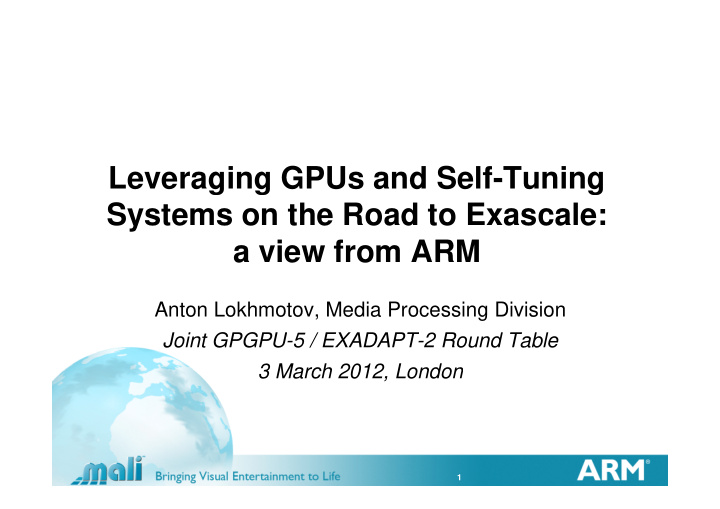



Leveraging GPUs and Self-Tuning Systems on the Road to Exascale: a view from ARM Anton Lokhmotov, Media Processing Division Joint GPGPU-5 / EXADAPT-2 Round Table 3 March 2012, London 1
ARM A company licensing IP to all major semiconductor companies (form of R&D outsourcing) Established in 1990 (spin-out of Acorn Computers) Headquartered in Cambridge, UK, with 27 offices in 13 countries and 2000+ employees ARM is the most widely used 32-bit CPU architecture Dates back to the mid 1980s (Acorn RISC Machine) Dominant in mobile devices (e.g. on average 3 processors per phone) Mali is the most widely licensed GPU architecture Dates back to the early 2000s (developed by Falanx, Norway) Media Processing Division established in 2006 (acquisition of Falanx) Released products: Mali-55 (OpenGL ES 1.1), Mali-200, Mali-400 (OpenGL ES 2.0) Mali-T604 (OpenGL ES 2.0 + OpenCL 1.1) 2
Landscape of accelerator programming Interface CUDA OpenCL DirectCompute RenderScript Originator NVIDIA Khronos (Apple) Microsoft Google Year 2007 2008 2009 2011 Area HPC, desktop Desktop, mobile, Desktop Mobile embedded, HPC OS Windows, Linux, Windows, Linux, Windows (Vista+) Android (3.0+) Mac OS Mac OS (10.6+) Devices GPUs (NVIDIA) CPUs, GPUs, GPUs (NVIDIA, CPUs, GPUs, custom AMD) DSPs Work unit Kernel Kernel Compute shader Compute script Language CUDA C/C++ OpenCL C HLSL Script C Distributed Source, PTX Source Source, bytecode LLVM bitcode Portability is likely to remain an issue despite standardisation efforts Performance portability is perhaps even more of an issue! 3
Performance tuning Why should we tune? To improve selected performance metrics (e.g. energy efficiency) What should we tune for? Architecture & implementation System behaviour (resource contention, failures) Data (probability distribution of characteristic inputs) When should we tune? Compile-time, run-time, install-time, idle-time… How should we tune? By automatically synthesising software based on extracted features 4
Challenges Understanding and exploring the search space (cf. EXADAPT) Extracting and interpreting features Using collective knowledge Enabling synthesis of efficient software (cf. GPGPU) Compilers have always had a limited ability to invent new algorithms Algorithm representation must be clear and flexible enough to enable powerful transformations What you generate may change over time (e.g. system and driver improvements) Marrying the above (cf. GPGPU+EXADAPT) 5
Final note Building exascale supercomputers is probably less important than making petascale embedded and mobile devices work together ! 6
Recommend
More recommend